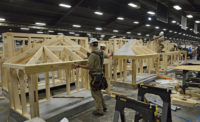The new smart vest is equipped with sensors that send a signal to an approaching car’s entertainment system, warning the driver of a construction zone further down the road. The vest also emits a signal or alarm to the worker to give them a few seconds of warning.
The smart vest is part of a system called InZone Alert. It was designed by researchers at Virginia Tech University, and could soon be worn by workers in Wisconsin.
"Any warning we can give them is better than no warning at all,” said Kristen Hines, a doctoral student with the Bradley Dept. of Electrical and Computer Engineering, said in a statement released by Virginia Tech. She is helping lead the combined effort of the College of Engineering and the Virginia Tech Transportation Institute.
Officials from the Wisconsin Dept. of Transportation have said they might use the smart vest for workers on their roads.
WisDOT collaborates with a university of Wisconsin research lab in Madison that tests various safety devices. The new Smart Vest is one in a series of technology related efforts to improve work zone and construction safety.
Recently, the Associated General Contractors of America said it would continue to provide highway work zone safety training classes in 2016, thanks to a federal grant. AGC will use the $120,000 grant from the U.S. Department of Labor to continue to provide safety-training classes for workers, in order to help prevent injuries among highway, bridge, and street construction workers.
According to federal statistics, 962 workers were killed at road construction sites between 2003 and 2010. A 2015 study done by AGC found that 50% of contractors had vehicles crash into their work zones during the past year. Workers were killed in 9 percent of those crashes, and were injured in 16 percent of them.





Post a comment to this article
Report Abusive Comment